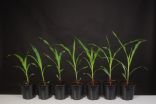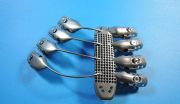Scientists learn how to predict plant size
2015-09-11
(Press-News.org) VIB and UGent scientists have developed a new method which allows them to predict the final size of a plant while it is still a seedling. Thanks to this method, which is based on the knowledge that a set of genes is associated with the final size of a leaf, scientists will be able to significantly accelerate plant breeding programs. The VIB/UGent scientists were able to identify this set of genes through advanced and highly detailed analyses. Expression analysis of specific genes will help breeders select the most useful crossing products at a very early stage.
Smart breeding thanks to good understanding of genetic processes
It takes a long time to develop new strains of plants with a greater yield or greater resistance to disease. Selecting the most useful crossing products, in particular, is a labor-intensive, time-consuming and expensive process. At present, breeding products must be manually infected to determine whether they are disease-resistant, while corn plants must first produce ears before their yield can be determined. This selection process can be made much more efficient by choosing plants on the basis of genetic data rather than on the basis of external characteristics. After all, many external properties are contained in DNA.
Thanks to an improved understanding of how plant growth and development are regulated at the molecular level, it is now known to a large extent which DNA sequences are responsible for which traits. By identifying the presence of such DNA sequences (also known as genetic markers) in seedlings, it is possible to predict at a very early stage whether the fully grown plants will be disease-resistant, even without having to infect the plants. This type of breeding is called marker-assisted breeding. A team of scientists from VIB and UGent, led by Prof. Dirk Inzé, developed a new method designed to predict the size of the leaves of a fully grown corn plant while the plant itself is still a seedling. This method is RNA-based rather than DNA-based.
RNA rather than DNA
Hereditary information is contained in DNA. However, not all information is needed in every plant cell. For instance, the genetic sequence causing plants to flower should not be activated in the roots. Before hereditary information can be expressed, the information in DNA must be transcribed to an RNA molecule, which is then translated into a protein . In other words, the set of all RNA molecules (also known as the transcriptome) provides a much greater insight into which genes actively contribute to a growth process. Plant scientist Dr. Joke Baute, a member of Prof. Dirk Inzé's VIB research group, and fellow scientists from the Italian Institute of Life Sciences in Pisa conducted a study into the transcriptome of the cell division zone in leaves of corn seedlings. The scientists were able to link a set of RNA molecules to external properties, which are not expressed until much later in the growth process, such as final leaf size and biomass production. This knowledge will allow breeders to make much more specific choices in the plant breeding process in the future. The scientists' results were published in two scientific papers in the journal Genome Biology.
More mouths to feed
Agriculture is facing great challenges worldwide. Although the United Nations has predicted that food production will have to increase by 70% by 2050 to feed the world's population, production levels are under pressure due to climate change and the demand for more environmentally friendly agricultural methods. Innovative strategies for plant breeding, soil management and cultivation methods will be required to achieve the necessary level of agricultural productivity without further destruction to valuable natural ecosystems.
VIB/UGent scientist Dirk Inzé: "We are world leaders in investigating the mechanisms which determine plant growth and plant size. These new insights will help us to accelerate the plant breeding process. In the long term, breeders will be able to select the most useful plants at a very early stage, which will considerably speed up breeding programs."
INFORMATION:
Relevant scientific publications
Joke Baute et al.
Correlation analysis of the transcriptome of growing leaves with mature leaf parameters in a maize RIL population
Genome Biology 2015
Dell'Acqua et al.
Genetic properties of the MAGIC maize population: a new platform for high definition QTL mapping in Zea mays.
Genome Biology 2015
[Attachments] See images for this press release:

ELSE PRESS RELEASES FROM THIS DATE:
2015-09-11
Tyrosine kinase 2 (Tyk2) is an enzyme involved in intracellular signalling and has an important role in activating the immune system. But enzymatically active Tyk2 can also promote excessive immune reactions and growth of certain cancer types.
Since several years, scientists are developing substances to specifically inhibit the kinase activity of Tyk2 for the treatment of inflammatory diseases and for potential use in cancer therapy. However, complications may occur: Tyk2 crucially contributes to the maturation and activation of natural killer (NK) cells. NK cells form ...
2015-09-11
After being diagnosed with a chest wall sarcoma, a 54-year-old Spanish man's surgical team made the decision to remove his sternum and a portion of his rib cage and replace it with an implant.
The implant was designed and manufactured by medical device company, Anatomics, who utilised the CSIRO's 3D printing facility, Lab 22 in Melbourne, Australia.
The surgical team, Dr José Aranda, Dr Marcelo Jimene and Dr Gonzalo Varela from Salamanca University Hospital, knew the surgery would be difficult due to the complicated geometries involved in the chest cavity.
The ...
2015-09-11
An approach to converting the data from MRI (magnetic resonance imaging) machines, mammograms and other medical equipment gives doctors a much clearer picture of your insides and a chance to detect disease and other problems earlier, according to research published in the International Journal of Biomedical Engineering and Technology. The technique known as the wavelet transform was first reported in 1910, but it was during the early 1990s that its applications in medicine and biomedical research first emerged and it is now reaching maturity as a technique to supplement ...
2015-09-11
Arterial wall stiffness and reduced arterial dilation are the first signs of cardiovascular diseases that can be measured. The Physical Activity and Nutrition in Children Study (PANIC) carried out in the Institute of Biomedicine at the University of Eastern Finland shows that low levels of physical activity, weaker physical fitness and higher body fat content are linked to arterial stiffness already in 6-8 year-old children. The study sample included 160 children, and the findings were published in Scandinavian Journal of Medicine and Science in Sports.
Physically active ...
2015-09-11
Genetics researchers from Case Western Reserve School of Medicine have identified a novel long non-coding RNA (lncRNA), dubbed DACOR1, that has the potential to stymie the growth of tumor cells in the second-most deadly form of cancer in the U.S. -- colorectal cancer.
The researchers found that this lncRNA is present in cells of healthy colons, but becomes suppressed in those carrying the disease. More importantly, this lncRNA interacts with a key enzyme known as DNMT1 that has important functions in all healthy cells of the body. Thus, the authors applied a name to ...
2015-09-11
As a potential treatment for Parkinson's disease, scientists at the University of North Carolina at Chapel Hill have created smarter immune cells that produce and deliver a healing protein to the brain while also teaching neurons to begin making the protein for themselves.
The researchers, led by Elena Batrakova, an associate professor at the UNC Eshelman School of Pharmacy's Center for Nanotechnology in Drug Delivery, genetically modified white blood cells called macrophages to produce glial cell-derived neurotrophic factor, or GDNF, and deliver it to the brain. Glial ...
2015-09-11
University of Otago palaeontology researchers are continuing to rewrite the history of New Zealand's ancient whales by describing two further genera and three species of fossil baleen whales.
They have named these newly described filter-feeding baleen whale species Waharoa ruwhenua, Tokarahia kauaeroa and re-identified Tokarahia lophocephalus, a poorly known species discovered in the 1950s.
All are eomysticetids--a whale family occupying an important position in the evolutionary tree of cetaceans--and Tokarahia appears to be a transitional fossil between primitive ...
2015-09-11
ANN ARBOR, Mich. -- Since the Food and Drug Administration (FDA) cautioned against using a minimally invasive method to treat fibroid tumors called power morcellation, there was a nearly quarter increase in hospital readmissions and 27 percent increase in major postoperative complications after hysterectomies in Michigan, a new University of Michigan study says.
After the first FDA safety communication in April 2014, the percent of women receiving minimally invasive hysterectomies in a large Michigan database also went down by an absolute 1.7 percent decrease.
The ...
2015-09-11
The pressure to be cool, look good and own the 'right stuff' is detrimental to many children and teenagers, according to new research by University of Sussex psychologists.
The study shows that, while many young people buy into consumer culture believing it will make them feel better about themselves and help them to make friends, often the reverse happens.
The result is a negative downward spiral, say the researchers, whereby those with low well-being turn to consumerist values, which impacts further still upon their state of mind.
In a UK study of 1,000 children ...
2015-09-11
Boston, MA -- Students with less than 20 minutes to eat school lunches consume significantly less of their entrées, milk, and vegetables than those who aren't as rushed, according to a new study from Harvard T.H. Chan School of Public Health.
The study will appear online Friday, September 11, 2015 in the Journal of the Academy of Nutrition and Dietetics.
"Many children, especially those from low-income families, rely on school meals for up to half their daily energy intake so it is essential that we give students a sufficient amount of time to eat their lunches," ...
LAST 30 PRESS RELEASES:
[Press-News.org] Scientists learn how to predict plant size

